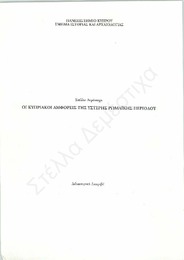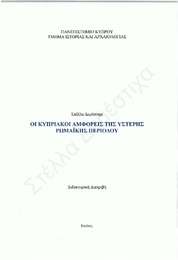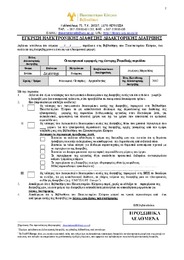| dc.contributor.advisor | Μιχαηλίδης, Δημήτρης | el |
| dc.contributor.author | Δεμέστιχα, Στέλλα | el |
| dc.coverage.spatial | Κύπρος | el |
| dc.coverage.spatial | Cyprus | en |
| dc.creator | Δεμέστιχα, Στέλλα | el |
| dc.date.accessioned | 2015-06-22T07:49:17Z | |
| dc.date.accessioned | 2017-08-03T10:32:04Z | |
| dc.date.available | 2015-06-22T07:49:17Z | |
| dc.date.available | 2017-08-03T10:32:04Z | |
| dc.date.issued | 2015-06-22 | |
| dc.date.submitted | 2002 | |
| dc.identifier.uri | https://gnosis.library.ucy.ac.cy/handle/7/39344 | en |
| dc.description | Αριθμός δεδηλωμένων πηγών στη βιβλιογραφία: 435 | el |
| dc.description | Διατριβή (Διδακτορική) -- Πανεπιστήμιο Κύπρου, Φιλοσοφική Σχολή, Τμήμα Ιστορίας και Αρχαιολογίας, 2002. | el |
| dc.description | Η βιβλιοθήκη διαθέτει αντίτυπο της διατριβής σε έντυπη μορφή. | el |
| dc.description.abstract | Κατά τη διάρκεια της ύστερη ρωμαϊκής περιόδου (4ος - 5ος αι. μ.Χ.) εμφανίστηκαν νέοι τύποι εμπορικών αμφορέων, κυρίως από τις ανατολικές Επαρχίες της Αυτοκρατορίας, ο χάρτης διασποράς των οποίων περιλαμβάνει ολόκληρη τη Μεσόγειο και τη Μαύρη Θάλασσα. Ανάμεσα στους πλέον διαδεδομένους τύπους είναι ο Late Roman Amphora 1 (στο εξής LR1), εργαστήρια του οποίου έχουν εντοπιστεί στις ακτές της Κιλικίας, στην Καρία, στη Ρόδο και στην Κύπρο. Κατά τη διάρκεια του 7ου αι. μ.Χ. στο σχηματολόγιο των κυπριακών εργαστηρίων προστέθηκε ένας ακόμη τύπος αμφορέα, ο Late Roman Amphora 13 (στο εξής LR13). H παρούσα μελέτη είχε στοχεύει στη διερεύνηση του ρόλου του νησιού στα εμπορικά δίκτυα της ανατολικής Μεσογείου κατά την ύστερη Ρωμαϊκή περίοδο, μέσα από την εξέλιξη της παραγωγής των αμφορέων LR1 και LR13.
Μεθοδολογία
Για να επιτευχθεί ο στόχος αυτός έπρεπε να γίνουν κατανοητές κατ' αρχήν οι συνθήκες παραγωγής των αγγείων, δηλαδή ο αριθμός των εργαστηρίων, οι μέθοδοι κατασκευής και η τυπολογική εξέλιξη των αμφορέων. Απαραίτητη επίσης κρίθηκε και η μελέτη της εμπορίας και της διασποράς των αμφορέων, εντός και εκτός Κύπρου.
Μελετήθηκαν σύνολα 605 τμηματικά σωζόμενοι αμφορείς LR1 και LR13 από της εξής θέσεις:
1. Εργαστήριο της Κάτω Πάφου (σωστική ανασκαφή στο χώρο του ξενοδοχείου Annabelle)
2. Αρχαία Αγορά Αμαθούντας
3. Αρχαία Αγορά Κουρίου
4. Mεγάλη N.A. Bασιλική Αμαθούντας
5. Αγιος T ύχωνας Aμαθούντας
6. Άγιος Γεώργιος Πέγειας
Ως αποτέλεσμα της μακροσκοπικής εξέτασης του πηλού των καταγεγραμμένων αμφορέων αλλά και με βάση τις πετρογραφικές αναλύσεις (οι οποίες πραγματοποιήθηκαν στο Τμήμα Γεωλογικής Επισκόπησης του Υπουργείου Γεωργίας της Κύπρου) διαχωρίστηκαν πέντε τοπικά εργαστήρια και δύο ακόμη, των οποίων η κυπριακή ταυτότητα δεν είναι απολύτως εξακριβωμένη. Προκειμένου να εξεταστούν οι συνθήκες παραγωγής, πραγματοποιήθηκαν πειραματικές ανακατασκευές αμφορέων σε παραδοσιακά αγγειοπλαστεία της Λευκωσίας. Διαπιστώθηκε ότι υπάρχουν δύο μόνο βασικοί τρόποι κατασκευής αγγείων με ημισφαιρική βάση και στη συνέχεια καταγράφηκαν αναλυτικά τα μορφολογικά αποτελέσματα των διαφορετικών τρόπων μορφοποίησης του πηλού, σε κάθε στάδιο.
Με δεδομένα και τα παραπάνω, επιχειρήθηκε κατ' αρχήν ο τυπολογικός διαχωρισμός των αμφορέων LR1, οι οποίο ήταν και οι περισσότεροι αριθμητικά. Tα κριτήρια της κατάταξης ήταν η διαμόρφωση των διαγνωστικών τους τμημάτων (χείλος, λαιμός λαβές) και οι βασικές διαστάσεις του λαιμού (Διάμετρος Στομίου και Υψος Λαιμού). Προκειμένου να μελετηθεί καλύτερα το σύνολο των κυπριακών LR1, ήταν απαραίτητη η ταξινόμηση και των δημοσιευμένων αμφορέων, οι οποίοι προέρχονταν από όλες σχεδόν τις παράκτιες θέσεις της Μεσογείου. Διαχωρίστηκαν δύο τύποι πρώιμων αμφορέων LR1 (4ος - 5ος αι. ) και τέσσερις τύποι της όψιμης φάσης (5ος -7° αι.).
Η ίδια διαδικασία ακολουθήθηκε και για τους αμφορείς LR13, οι οποίοι διαχωρίστηκαν σε δύο κύριες ομάδες.
Συμπεράσματα
Η παραγωγή αμφορέων στην Κύπρο κατά τους ύστερους ρωμαϊκούς χρόνους ε.ιναι ενδεικτική της εμπλοκής του νησιού στα εμπορικά δίκτυα της ανατολικής Μεσογείου. Η παραγωγή εντάθηκε στα τέλη του 6ου αιώνα, οπότε η Κύπρος φαίνεται ότι είτε κατόρθωσε να διατηρήσει το εμπορικό δίκτυο που είχε δημιουργήσει από τον προηγούμενους αιώνες είτε ίσως αναγκάστηκε να εντατικοποιήσει τις εξαγωγές της για να αναπληρώσει το κενό που δημιουργήθηκε από τις απώλειες των εδαφών της γειτονικής Αντιόχειας και της Αιγύπτου. Η παραγωγή αμφορέων στο νησί ήταν αποτέλεσμα των ευνοϊκών αυτών συνθηκών, οι οποίες διήρκεσαν περίπου δύο αιώνες. | el |
| dc.description.abstract | During the late Roman period (4th - 7th centuries AD), new transport amphorae appeared, mainly in the eastern provinces of the Empire. Their distribution map includes the entire Mediterranean and the Black Sea. Among the most common types is the Late Roman Amphora 1 (LR1), workshops of which have been located in the Cilician coasts, in Caria, Rhodes and Cyprus. During the 7th century, a new type, the Late Roman Amphora 13 (LR13) was added in the repertoire of the Cypriot workshops. This study aims at investigating the role of Cyprus in the trade networks of the eastern Mediterranean during the Late Roman period, as evidenced by the development of the LR1 and LR13 amphora production.
Methodology
In order to achieve the above mentioned objective, it was necessary firstly to understand the conditions of the amphora production on the island: the number of the workshops, the construction methods and the typology of the vessels. It was also necessary to investigate the trade and diffusion of these amphorae, in and outside Cyprus.
A total of 605 partly preserved LR1 and LR13 amphorae were studied from the following sites:
7. Kato Paphos Kiln Site (rescue excavation at Annabelle Hotel)
8. Agora of Amathus
9. Agora of Kourion
10. Amathous coastal Basilica
11. Ayios Tychon, Amathous
12. Ayios Georghios, Peyia
Five Cypriot workshops and two more of uncertain origin were distinguished, as a result of macroscopic study of the catalogued amphorae fabrics but also according to petrographic analysis, conducted by the Department of Geological Survey, Ministry of Agriculture and Natural Resources , Cyprus. Moreover and in order to study better the different sub-types, experiments in amphora manufacture were conducted in two traditional pottery workshops of Nicosia.
Both potters used two techniques, widely used to make vessels with a convex base. During each step of these techniques, the different marks left on the vessels' surface were recorded in detail.
The typological distinction of the Cypriot LR1 amphorae was made on the basis of the fabric and the characteristics of the different manufacturing techniques. The morphology of the vessels' diagnostic parts (rim, neck, handles), the average dimensions of the neck (diameter and height) were also taken into consideration. The published LR1 amphorae from diverse Mediterranean sites were classified according to the same typology: two early types (4th - 5th centuries AD) and four later ones (5th - 7th centuries AD) were distinguished. The Cypriot LR13 amphorae were divided in two groups (rather than types), as only few vessels were examined.
Conclusions
The amphora production in Cyprus during the late Roman period is indicative of the island's involvement in the trade networks of the eastern Mediterranean. This production was intensified at the end of the 6th century AD, when Cyprus managed to maintain its previous trade contacts, despite the wars that broke out at the neighbouring province; or these networks were enhanced because of the loss of Antioch and Egypt. Thus, the amphora production was directly influenced by these conditions, which remained favourable for Cyprus for about two centuries. | en |
| dc.format.extent | 3 τ. : πιν., εικ., χάρτες ; 30 εκ. | el |
| dc.language.iso | gre | en |
| dc.publisher | Πανεπιστήμιο Κύπρου, Φιλοσοφική Σχολή / University of Cyprus, Faculty of Letters | |
| dc.rights | info:eu-repo/semantics/openAccess | en |
| dc.rights | Open Access | en |
| dc.subject.lcsh | Amphoras Mediterranean Region | en |
| dc.subject.lcsh | Pottery, Ancient Mediterranean Region | en |
| dc.subject.lcsh | Mediterranean Region Antiquities | en |
| dc.subject.lcsh | Mediterranean Region Commerce | en |
| dc.title | Οι κυπριακοί αμφορείς της ύστερης ρωμαϊκής περιόδου | el |
| dc.title.alternative | Cypriot Amphorae of the Late Roman Period | en |
| dc.type | info:eu-repo/semantics/doctoralThesis | en |
| dc.contributor.committeemember | Ιακώβου, Μαρία | el |
| dc.contributor.committeemember | Τριανταφυλλόπουλος, Δημήτριος | el |
| dc.contributor.committeemember | Βαλαβάνης, Πάνος | el |
| dc.contributor.committeemember | Iakovou, Maria | en |
| dc.contributor.committeemember | Triantafyllopoulos, Demetrios | en |
| dc.contributor.committeemember | Valavanis, Panos | en |
| dc.contributor.committeemember | Sodini, Jean-Pierre | en |
| dc.contributor.department | Πανεπιστήμιο Κύπρου, Φιλοσοφική Σχολή, Τμήμα Ιστορίας και Αρχαιολογίας | el |
| dc.contributor.department | University of Cyprus, Faculty of Letters, Department of History and Archaeology | en |
| dc.subject.uncontrolledterm | ΑΜΦΟΡΕΙΣ | el |
| dc.subject.uncontrolledterm | ΑΡΧΑΙΑ ΚΕΡΑΜΕΙΚΗ ΤΕΧΝΟΛΟΓΙΑ | el |
| dc.subject.uncontrolledterm | ΥΣΤΕΡΗ ΡΩΜΑΪΚΗ ΠΕΡΙΟΔΟΣ | el |
| dc.subject.uncontrolledterm | ΚΥΠΡΙΑΚΗ ΑΡΧΑΙΟΛΟΓΙΑ | el |
| dc.subject.uncontrolledterm | ΘΑΛΑΣΣΙΟ ΕΜΠΟΡΙΟ | el |
| dc.subject.uncontrolledterm | ΕΜΠΟΡΙΟ ΚΡΑΣΙΟΥ ΚΑΙ ΛΑΔΙΟΥ | el |
| dc.subject.uncontrolledterm | AMPHORAE | en |
| dc.subject.uncontrolledterm | ANCIENT POTTERY TECHNOLOGY | en |
| dc.subject.uncontrolledterm | LATE ROMAN PERIOD | en |
| dc.subject.uncontrolledterm | ARCHAEOLOGY OF CYPRUS | en |
| dc.subject.uncontrolledterm | SEA TRADE | en |
| dc.subject.uncontrolledterm | TRADE OF WINE AND OLIVE OIL | en |
| dc.identifier.lc | NK4650.A6.D46 2001 | en |
| dc.author.faculty | Φιλοσοφική Σχολή / Faculty of Letters | |
| dc.author.department | Τμήμα Ιστορίας και Αρχαιολογίας / Department of History and Archaeology | |
| dc.type.uhtype | Doctoral Thesis | en |
| dc.rights.embargodate | 2002 | |



